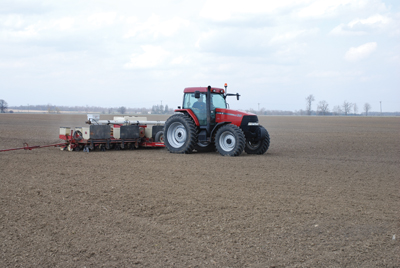
News
Ontario’s new CHU system fires some discussion
As farmers check the new Crop Heat Unit (CHU) maps for Ontario,
April 2, 2010 By Blair Andrews
As farmers check the new Crop Heat Unit (CHU) maps for Ontario, they may notice that their region appears warmer than previous maps indicated. Although global warming has emerged as a hot topic in recent years, the increase in heat units actually represents modifications to farming practices, rather than climate change.
 |
| Growers today are pushing their hybrids earlier in the spring, and an update on the original map, now 45 years old, was long overdue.
Photo by Ralph Pearce.
Advertisement
|
The goal of the revised CHU index is to more accurately reflect today’s earlier planting dates, giving growers a more consistent method of comparing the performance of corn hybrids across the province. More than five years in the making, the new system and maps debuted in the March 2009 Agronomy Guide, with 2010 being the first hybrid corn seed sales season to use the new CHU map. The revised index is based on two key changes. It uses weather records from 1971 to 2000 as opposed to 1961 to 1990, and it standardizes the starting or planting dates for all areas of the province to May 1.
Ian Nichols, business manager of Weather INnovations Incorporated (WIN) in Chatham, Ontario, says the previous index was created more than 45 years ago, when farmers would generally wait for the ground to warm up before they would plant. The starting date for accumulating heat units was triggered by two components. For the first threshold, the normal average temperature for a location had to reach 10 degrees C. The second rule called for three consecutive days of average temperatures of 12.8 degrees C before one could begin counting heat units.
While the system may have been agronomically sound, Nichols says it became an inconsistent tool for analysis because not everyone was employing both components of the rule. “It just didn’t seem to fit because people tend to plant when the ground is in good condition from a soil moisture standpoint, rather than from a temperature standpoint,” says Nichols.
As WIN received more requests for year-over-year comparisons of growing conditions and other situations, Nichols says the previous system tended to provide information that was slightly confusing and erroneous.
Heat unit shift altered by standardized planting date
The new system is designed to reflect more accurately the actual accumulation of CHUs for the crop, which may be planted earlier than the traditional start date. “I loosely suggested that we come up with a standard start date across the province and see what happens to the CHU values,” says Nichols, recalling his recommendation for the revision in 2002. “Everybody starts on May 1, and we get rid of some comparisons where the rules weren’t consistently applied. It’s more focused on cropping habits and it gives them an opportunity to have a really good measuring stick, which has some standardization.”
With the changes, regions across the province gained heat units. The increases were lowest in the warmest regions of Ontario, including Kent and Essex counties and most of the Niagara Peninsula. The largest increases of about 200 to 220 units tended to be along the colder lakes, specifically, the north shore of Lake Ontario, and along Lake Huron and Georgian Bay. Higher elevations and higher latitudes also gained many CHUs from the earlier start date. “It’s not completely off the wall in the sense that the old map was relatively conservative,” says Greg Stewart, Ontario Ministry of Agriculture, Food and Rural Affairs corn specialist. “If you were in a 2900 heat unit area, you were probably growing hybrids that were rated 3000 or 3100, if you were planting early. So we’re in a bit of a process of getting farmers used to the new map and new system.”
Stewart agrees with the assessment that the older system was losing its value as a tool for comparing corn hybrid data. “It was slightly problematic in the sense that the people in Ridgetown started counting heat units long before the people in Barrie did,” explains Stewart. “But over time, as we have had more seed vigour and better seed treatments, the guys in Barrie are just as prone to plant on May 1, if the soil is fit, as the people in Ridgetown.”
Stewart says the new system also reflects the growers’ acceptance of the concept that planting early can boost yield potential. “And that’s true in Ridgetown and in Barrie. Farmers across the province have come to an increased realization that early planting is critical.”
From a seed industry perspective, Shawn Winter, product development manager at Maizex Seeds, expects growers will quickly adapt to the new CHU index. He notes that the system confirms how most growers have been selecting their varieties for the past five years. “If you exclude Southwestern Ontario, farmers are pushing heat units. They do see the advantage of growing longer heat unit varieties,” says Winter, adding that a minimal number of hybrid ratings would need to change as a result of the new CHU index.
As growers continue to seek information about hybrid performance, Nichols says the new system will help them track and analyze the data from the day they plant. “For clarity of communicating with producers as to how areas differ and how years differ, it is important to have a standard reference starting date.”
The standard also makes it easier for growers to use a CHU tool on the WIN website to track and calculate CHUs for individual fields. Over time, Nichols hopes that a grower will be able to use the more accurate information to judge better which corn hybrid is most suitable for his or her farm.